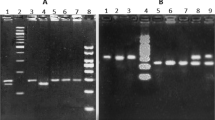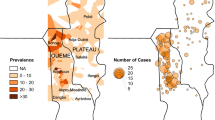Abstract
Similar to other mycobacterial diseases, susceptibility to Buruli ulcer (Mycobacterium ulcerans infection) may be determined by host genetic factors. We investigated the role of SLC11A1 (NRAMP1) in Buruli ulcer because of its associations with both tuberculosis and leprosy. We enrolled 182 Buruli ulcer patients (102 with positive laboratory confirmation) and 191 healthy neighbourhood-matched controls in Ghana, and studied three polymorphisms in the SLC11A1 gene: 3′ UTR TGTG ins/del, D543N G/A, and INT4 G/C. Finger prick blood samples from study subjects were dried on filter papers (FTA) and processed. D543N was significantly associated with Buruli ulcer: the odds ratio (adjusted for gender, age, and region of the participant) of the GA genotype versus the GG genotype was 2.89 (95% confidence intervals (CI): 1.41–5.91). We conclude that a genetic polymorphism in the SLC11A1 gene plays a role in susceptibility to develop Buruli ulcer, with an estimated 13% population attributable risk.
This is a preview of subscription content, access via your institution
Access options
Subscribe to this journal
Receive 6 digital issues and online access to articles
$119.00 per year
only $19.83 per issue
Buy this article
- Purchase on Springer Link
- Instant access to full article PDF
Prices may be subject to local taxes which are calculated during checkout
Similar content being viewed by others
References
Van der Werf TS, van der Graaf WTA, Tappero JW, Asiedu K . Mycobacterium ulcerans infection. Lancet 1999; 9183: 1013–1018.
Asiedu K, Scherpbier RW, Raviglione M . Buruli ulcer – Mycobacterium ulcerans infection. WHO Geneva: World Health Organization, 2000.
Van der Werf TS, Stinear T, Stienstra Y, Van der Graaf WTA, Small PL . Mycolactones and Mycobacterium ulcerans disease. Lancet 2003; 9389: 1062–1064.
Ellen DE, Stienstra Y, Teelken MA, Dijkstra PU, Van der Graaf WTA, Van der Werf TS . Assessment of functional limitations caused by Mycobacterium ulcerans infection: towards a Buruli Ulcer Functional Limitation Score. Trop Med Int Health 2003; 1: 90–96.
Stienstra Y, Dijkstra PU, Guedenon A, Johnson RC, Ampadu EO, Mensah T et al. Development of a questionnaire assessing Buruli ulcer-induced functional limitation. Am J Trop Med Hyg 2004; 3: 318–322.
Debacker M, Aguiar J, Steunou C, Zinsou C, Meyers WM, Guedenon A et al. Mycobacterium ulcerans disease (Buruli ulcer) in rural hospital, southern Benin, 1997–2001. Emerg Infect Dis 2004; 8: 1391–1398.
Stienstra Y, van der Graaf WTA, te Meerman GJ, The TH, de Leij LF, Van der Werf TS . Susceptibility to development of Mycobacterium ulcerans disease: review of possible risk factors. Trop Med Int Health 2001; 7: 554–562.
Fitness J, Tosh K, Hill AV . Genetics of susceptibility to leprosy. Genes Immun 2002; 8: 441–453.
Bellamy R . Susceptibility to mycobacterial infections: the importance of host genetics. Genes Immun 2003; 1: 4–11.
Cellier M, Govoni G, Vidal S, Kwan T, Groulx N, Liu J et al. Human natural resistance-associated macrophage protein: cDNA cloning, chromosomal mapping, genomic organization, and tissue-specific expression. J Exp Med 1994; 5: 1741–1752.
Bellamy R, Ruwende C, Corrah T, McAdam KP, Whittle HC, Hill AV . Variations in the NRAMP1 gene and susceptibility to tuberculosis in West Africans. N Engl J Med 1998; 10: 640–644.
Abel L, Sanchez FO, Oberti J, Thuc NV, Hoa LV, Lap VD et al. Susceptibility to leprosy is linked to the human NRAMP1 gene. J Infect Dis 1998; 1: 133–145.
Meisner SJ, Mucklow S, Warner G, Sow SO, Lienhardt C, Hill AV . Association of NRAMP1 polymorphism with leprosy type but not susceptibility to leprosy per se in West Africans. Am J Trop Med Hyg 2001; 6: 733–735.
Goswami T, Bhattacharjee A, Babal P, Searle S, Moore E, Li M et al. Natural-resistance-associated macrophage protein 1 is an H+/bivalent cation antiporter. Biochem J 2001; 354: 511–519.
Hayman J . Out of Africa: observations on the histopathology of Mycobacterium ulcerans infection. J Clin Pathol 1993; 1: 5–9.
George KM, Chatterjee D, Gunawardana G, Welty D, Hayman J, Lee R et al. Mycolactone: a polyketide toxin from Mycobacterium ulcerans required for virulence. Science 1999; 5403: 854–857.
Coutanceau E, Marsollier L, Brosch R, Perret E, Goossens P, Tanguy M et al. Modulation of the host immune response by a transient intracellular stage of Mycobacterium ulcerans: the contribution of endogenous mycolactone toxin. Cell Microbiol 2005; 8: 1187–1196.
Analyze blood and buccal DNA after years of room temperature storage. http://www.whatman.com/repository/documents/s7/WGP_165_A.pdf.
Hao K, Li C, Rosenow C, Wong WH . Detect and adjust for population stratification in population-based association study using genomic control markers: an application of Affymetrix Genechip(R) Human Mapping 10 K array. Eur J Hum Genet 2004; 12: 1001–1006.
Raghunathan PL, Whitney EAS, Asamoa K, Stienstra Y, Taylor Jr TH, Amofah GK . et al. Risk Factors for Buruli Ulcer Disease (Mycobacterium ulcerans infection): Results From a Case–Control Study in Ghana. Clin Infect Dis 2005; 10: 1445–1453.
Okenu DMN, Ofielu LO, Easley KA, Guarner J, Spotts Whitney EA, Raghunathan PL et al. Immunoglobulin M antibody responses to Mycobacterium ulcerans allow discrimination between cases of active Buruli ulcer disease and matched family controls in areas where the disease is endemic. Clin Diagn Lab Immunol 2004; 2: 387–391.
Guarner J, Bartlett J, Whitney EAS, Raghunathan PL, Stienstra Y, Asamoa K et al. Histopathologic features of Mycobacterium ulcerans infection. Emerg Infect Dis 2003; 6: 651–656.
Stienstra Y, Van der Werf TS, Guarner J, Raghunathan PL, Whitney EAS, Van der Graaf WTA et al. Analysis of an IS2404-based nested PCR for diagnosis of Buruli ulcer disease in regions of Ghana where the disease is endemic. J Clin Microbiol 2003; 2: 794–797.
Stienstra Y, Dijkstra PU, van Wezel MJ, Van Roest MH, Beets M, Zijlstra IJ et al. Reliability and validity of the Buruli ulcer functional limitation score (BUFLS) questionnaire. Am J Trop Med Hyg 2004; 4: 449–452.
Acknowledgements
We thank Ilona Hospers and Irene Wiersma for the collection of samples. Furthermore, we thank the staff from the following institutions for assisting with field data collection: District Health Administration and Dunkwa Government Hospital, Dunkwa-on-Offin; St Martin's Catholic Hospital, Agroyesum; and Agogo Presbyterian Hospital, Agogo.
This research was funded by the NWO (Dutch Organisation for Scientific Research), the Jan Kornelis de Cock Foundation, and the Centers for Disease Control and Prevention.
Author information
Authors and Affiliations
Corresponding author
Additional information
Contribution of authors
Ymkje Stienstra helped to design the study, collected data, coordinated international cooperation, and was responsible for the preparation of the paper. Tjip van der Werf designed and supervised the study, and coordinated international cooperation. Elvira Oosterom performed the laboratory analysis. Ilja Nolte was responsible for the statistical analysis. Winette van der Graaf designed and supervised the study, and coordinated international cooperation. Samuel Etuaful contributed to data collection and its supervision. Pratima Raghunathan and Ellen Whitney-Spotts were responsible for the design of the study, data collection, and contributed to data interpretation. Edwin Ampadu and Kwame Asamoa were responsible for the international cooperation and the supervision of the field activities. Erasmus Klutse contributed to data collection and its supervision. Gerard te Meerman contributed to study methods, and interpretation of results. Jordan Tappero and David Ashford designed and supervised the study, and coordinated international cooperation. Gerrit van der Steege helped in the study design, coordinated analysis, and supervised interpretation of results. All authors helped to write the paper.
Rights and permissions
About this article
Cite this article
Stienstra, Y., van der Werf, T., Oosterom, E. et al. Susceptibility to Buruli ulcer is associated with the SLC11A1 (NRAMP1) D543N polymorphism. Genes Immun 7, 185–189 (2006). https://doi.org/10.1038/sj.gene.6364281
Received:
Revised:
Accepted:
Published:
Issue Date:
DOI: https://doi.org/10.1038/sj.gene.6364281
Keywords
This article is cited by
-
Genome-wide association study of Buruli ulcer in rural Benin highlights role of two LncRNAs and the autophagy pathway
Communications Biology (2020)
-
Human genetics of Buruli ulcer
Human Genetics (2020)
-
The immunology of other mycobacteria: M. ulcerans, M. leprae
Seminars in Immunopathology (2020)
-
Buruli Ulcer: a Review of the Current Knowledge
Current Tropical Medicine Reports (2018)
-
Human genetics of mycobacterial disease
Mammalian Genome (2018)



